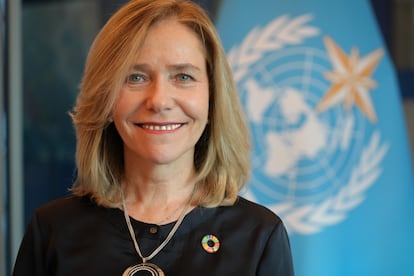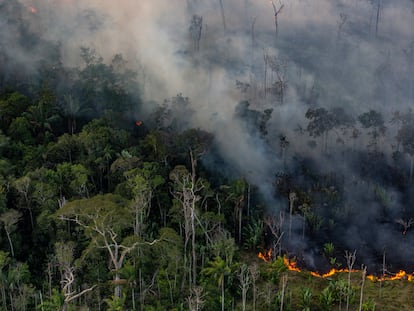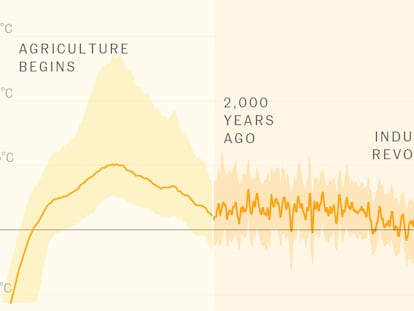Celeste Saulo, Secretary-General of the World Meteorological Organization: ‘There’s a disconnect between what the science shows, and the speed of our response’
The Argentine meteorologist assumed her role as head of the agency on January 1, becoming the first woman, and first South American, to hold the position


On January 1, 2024, Celeste Saulo (Buenos Aires, 59 years old) was appointed Secretary-General of the World Meteorological Organization (WMO), becoming the first woman to head the organization, which plays a leading role in the global fight against climate change. A meteorologist and director of Argentina’s National Meteorological Service since 2014, Saulo was appointed to the post by the World Meteorological Congress — a body linked to the UN and involving all 193 countries — in June of last year. From her newly opened office in Geneva, Switzerland, she spoke to EL PAÍS via video call.
Question: Where do we stand right now with respect to climate change?
Answer: The warnings are clear, and are detailed in last year’s IPCC report. Global warming is increasing, and it’s undoubtedly due to human activity: the burning of fossil fuels, agricultural exploitation, and the use of fertilizers and changes in land use practices. On top of this, all calculations indicate that the concentration of greenhouse gases continues to increase. In the words of the Secretary-General of the United Nations, the window of opportunity for taking action is getting smaller and smaller. This is the reality, and in the face of this, as global citizens with varying levels of responsibility, we need to act.
Q: Within this window of action, which, as you say, is shrinking, what are your objectives for the next four years as head of the WMO?
A: The most important role the organization plays is to provide information that allows productive sectors to make decisions on how to produce goods in a sustainable way, while ensuring access to food and water, of course. And to support adaptation measures, so that we can use meteorological and hydrological services, which provide forecasts and early warnings, to protect populations, their assets and material resources, and their sources of employment.
Q: How?
A: Through the provision of information about the climate. Through the continuous monitoring of how the atmosphere is evolving, which is the instrument that the WMO uses to support the meteorological and hydrological services of other countries, so they can take action. This can come in the form of very short-term actions, such as preparing for an acute extreme weather event, or medium-term actions, such as planning for a scenario where, for example, the precipitation patterns are changing, either increasing or decreasing.
Q: What are the main challenges for 2024?
A: The WMO has made it a priority for all citizens of the world to have access to early warning systems. Unfortunately, there’s still a lot of work to do. Approximately 50% of countries do not have early warning systems. I view this as a fundamental aspiration, and we will all have to mobilize resources to make it possible.
We also need to maintain state systems to measure and monitor the atmosphere, the oceans, the ice, the rivers, as well as the sustaining and strengthening permanent monitoring. You can’t really intervene or understand what’s happening to complex systems like climate, water, ice, if you don’t take measurements, if you don’t study it, and if you don’t give scientists what they need to understand what’s happening. And, thirdly, we need to work directly with individual countries. Decisions can be made from the top down, but things happen at the state level.
Q: And are individual countries taking action fast enough?
A: No, and this has to change. I want to distinguish opinion from fact: we are a very technical organization; we deal with numbers, and the numbers say no. The temperature is increasing, greenhouse gas emissions are increasing. The actions that we are taking are evidently neither sufficient nor do they result in what one would expect to see reflected. It’s true, yes, that there are commitments from countries and actions that are being taken; it would be unfair not to recognize this, but these action are insufficient. On this point, I don’t think there’s any room for debate.
Q: So, are we headed in the right direction?
A: We need to accelerate our actions, to make them effective. Country’s make various commitments at different meetings, but then they don’t turn those commitments into concrete actions. There are barriers of all kinds: governance, administrative, political. We’re still not doing what we should be doing, and all the actors involved need to be moving faster. This involves decision making, it involves the management of funds, just transitions, which there has been a lot of talk about, but ultimately the funds that developing countries are demanding are not arriving, they’re not being effective.
Q: Why are things not moving faster?
A: I think it’s a collective responsibility, and each actor in the cycle has to speed up their part of the process. We’re all are aware that organizations like the United Nations have their own bureaucracies, their own discussions, debates, agreements and consensus, but when things get down to the more local level, we find the same kind of obstacles or bureaucracies. There are mechanisms that must be put into play to accelerate what we say we want to accelerate. There’s a disconnect between what the science obviously shows us, and the speed of our response. If you try to stop a vehicle and the brakes aren’t responding, then you ask yourself: “Am I not pressing the pedal hard enough, or are my brakes not working properly?”
Q: In an interview last summer, you said that the climate system did not react in a linear fashion. What does that mean?
A: It means that if you have a glass full of water and you dump half of it out, you haven’t solved the problem of having too much water. What can sometimes be difficult to put in perspective is that the emission of greenhouse gases needs to be decreasing, so that in 20 years we can start to see a reduction in global warming. There are some interactions that are still not fully understood, such as the melting of the poles, and the warming or acidification of the oceans. We’re still trying to understand how changing just one thing can end up changing the system as a whole, because it’s a very nonlinear system. Once you disturb it, it’s very difficult to know how it’s going to evolve. The system has already been forced out of equilibrium, and what we have to try to do now is get it back into balance, within the parameters available to us.
Q: Do we have greater climate awareness now?
A: We are becoming more aware of the impact of climate change for the simple reason that there are fewer and fewer people who can say they were surprised by an extreme event to which they had never been exposed before. Now, getting from that point to the point of awareness that everyone can do something about it, so that warming doesn’t continue to increase, is different. There are different sectors with important roles, from politics, to education, to non-governmental organizations or the UN as a whole. So that’s where see a call to action, an awareness that what I do every day can contribute or not contribute to this continuing to happen, and I think it’s part of what we need to take on.
Q: Do you worry about an increase in denialism?
A: I would say that denialism is decreasing substantially, and that what we’re seeing now is a somewhat exaggerated expectation about what science can do to solve what we have not been able to solve as a global society. I think it’s asking too much of science, and it’s a way of externalizing responsibility. Of course, science, as long as it can do something, will do it. It will provide data, just as it has done for many years. The Nobel Prize in physics in 2021 was awarded to a scientist precisely for his early research on the impact of increased carbon dioxide on the average temperature of the planet, and that research dates back to the late sixties. So, are we going to ask science for everything, when science has been telling us what to do for many years?
Q: What worries you the most?
A: All the structures of our global community need to start moving, and everyone needs to do their part. Everyone has a role to play, and I’m concerned that the level of dialogue is insufficient to move things from meeting agendas and to concrete action. I’m also worried that countries won’t be able to do what they need to do, that they don’t have the means to do it, or the financial and technical support they need.
Q: You’ve mentioned on more than one occasion that “it’s wrong to talk about natural disasters.” Why?
A: A volcanic eruption is a threat that is natural: it happens in nature and it’s uncontrollable, and the same goes for a storm or a hurricane, a flood, or a drought. Now, what makes it become a disaster? That there is a population that is exposed, that has not been able to protect itself, whose homes are too vulnerable or are located in places where people shouldn’t be living. So what was a natural threat and a natural phenomenon becomes a disaster, but not because nature produced the disaster. It’s a combination of factors that are created by humans: how we live, where we live, how we prepare ourselves, how we plan, and what decisions we make determine whether a threat, which can be very serious, becomes a disaster or is simply a threat with manageable damage.
Q: This year has been the warmest on record, and 2024 could be even warmer yet. There has been a lot of talk about the El Niño phenomenon — what exactly is it, and what are its consequences?
A: El Niño is a phenomenon that we have already documented quite extensively. It’s part of the natural variability of the climate; it’s a natural oscillation that repeats itself. The effects are not the same all over the world, which is something we need to keep in mind, but on average, globally, it balances out as a generally warmer period. In an El Niño scenario, we expect that 2024 could also be a much warmer year than average, which will just mean even warmer trends than we would otherwise be experiencing. The concern is not with El Niño per se, but rather the general trend towards higher temperatures.
Q: Do you think we will surpass the 1.5 degree limit in the next few years?
A: The IPCC clearly states that the possibilities of exceeding that limit are high, because measures have not been taken to reduce greenhouse gas emissions. We also need to distinguish between one year of exceeding the limit and a decade where the average exceeds the limit, and that’s the biggest warning sign. Statistics allow for fluctuations and we understand these fluctuations, but they are superimposed over an upward trend, and it’s this trend that’s worrying.
Q: Is there any room for optimism when talking about climate change?
A: Yes, there’s always room for optimism. There’s something for everyone to do. I don’t think we have permission to do nothing. No person has permission to do nothing. In that sense, I think we should be optimistic, if we trust in human nature, in the possibility of rescuing our planet, because we’re not just thinking about ourselves, but about those who come after us. Future generations deserve a livable planet. And in the face of that reality, I think it’s impossible to take the position that we just don’t care about anything.
Sign up for our weekly newsletter to get more English-language news coverage from EL PAÍS USA Edition
Tu suscripción se está usando en otro dispositivo
¿Quieres añadir otro usuario a tu suscripción?
Si continúas leyendo en este dispositivo, no se podrá leer en el otro.
FlechaTu suscripción se está usando en otro dispositivo y solo puedes acceder a EL PAÍS desde un dispositivo a la vez.
Si quieres compartir tu cuenta, cambia tu suscripción a la modalidad Premium, así podrás añadir otro usuario. Cada uno accederá con su propia cuenta de email, lo que os permitirá personalizar vuestra experiencia en EL PAÍS.
¿Tienes una suscripción de empresa? Accede aquí para contratar más cuentas.
En el caso de no saber quién está usando tu cuenta, te recomendamos cambiar tu contraseña aquí.
Si decides continuar compartiendo tu cuenta, este mensaje se mostrará en tu dispositivo y en el de la otra persona que está usando tu cuenta de forma indefinida, afectando a tu experiencia de lectura. Puedes consultar aquí los términos y condiciones de la suscripción digital.
More information
Últimas noticias
Susan Boyle prepares a comeback just as Timothée Chalamet sings her praises
Trump suspends green card visa lottery after shooting at Brown University
When things get out of hand at the lab: Hundreds of accidents expose the ‘catastrophic’ risk of dangerous pathogen leaks
Venezuelan migrants contribute billions of dollars to Latin America, but continue to work in the informal sector
Most viewed
- Christian Louboutin: ‘Young people don’t want to be like their parents. And if their parents wear sneakers, they’re going to look for something else’
- Cartels in Mexico take a leap forward with narco-drones: ‘It is criminal groups that are leading the innovation race’
- Liset Menéndez de la Prida, neuroscientist: ‘It’s not normal to constantly seek pleasure; it’s important to be bored, to be calm’
- ‘El Limones’ and the growing union disguise of Mexican organized crime
- The low-cost creative revolution: How technology is making art accessible to everyone










































